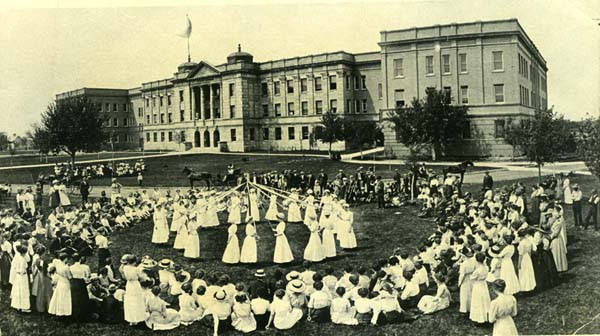Search the Blog
Categories
- Books & Reading
- Broadband Buzz
- Census
- Education & Training
- General
- Grants
- Information Resources
- Library Management
- Nebraska Center for the Book
- Nebraska Memories
- Now hiring @ your library
- Preservation
- Pretty Sweet Tech
- Programming
- Public Library Boards of Trustees
- Public Relations
- Talking Book & Braille Service (TBBS)
- Technology
- Uncategorized
- What's Up Doc / Govdocs
- Youth Services
Archives
Subscribe
Category Archives: Information Resources
Publications Clearinghouse is 40 Years Old
The Nebraska Publications Clearinghouse Service at the Library Commission turned 40 in July! There have been many changes in how we do things, particularly providing access to government information and publications digitally rather than in tangible format. But our purpose remains the same: to provide access to and assistance in locating government information for Nebraska citizens, staff of Nebraska libraries and state agencies, and the Nebraska legislature.
Prior to 1972 there was no comprehensive program in the state for collecting and preserving Nebraska government publications. In 1971 the Nebraska Library Commission began surveying other states and Nebraska libraries to find out how such a program should work and drafting proposed legislation to give the program legal authority. In January 1972 LB 1284 was introduced in the Nebraska Legislature, passed and signed by the Governor in March establishing the Nebraska Publications Clearinghouse. The program was launched in July of that year.
State Depository Program: “There is hereby created, as a division of the Nebraska Library Commission, a Nebraska Publications Clearinghouse. The clearinghouse shall establish and operate a publications collection and depository system for the use of Nebraska citizens” The original legislation has been amended several times to exclude Junior Colleges and reduce the number of mandatory copies that agencies must send. In 2005 distribuution to the 13 state documents depositories changed from microfiche shipments to notifications about additions to our digital state documents collection.
Federal Depository Program The legislation also directed the Library Commission to provide access to federal publications. “The Nebraska Publications Clearinghouse shall provide access to local, state, federal and other governmental publications to state agencies and legislators and through interlibrary loan service to citizens of the state.” The Commission began participating in the Federal Depository Library Program (FDLP) in 1972. It served as Nebraska’s Regional Federal Depository until 1984, when Love Library at the University of Nebraska-Lincoln became the Regional. The Commission is now a selective depository and has reduced its selections to about 2% of the publications offered through the program. Many of those are digital publications that we do not receive in tangible format but link to from our online catalog.
Subject Headings: The Original Tags
If you’ve spent any time browsing the collections in Nebraska Memories, you have probably noticed that each item has a list of terms next to the word Subject. These are called subject headings, which is librarian-speak for words that tell you what a particular item is about. They are similar to tags that you might use to describe things on social networking sites, like pictures on Flickr. The difference is that while you can use whatever tags you want, subject headings are chosen from a specific list of words.
Why do we add subject headings to the Nebraska Memories records, and how can they help you search? For one thing, they bring together all of the items that have the same subject heading, so that you can find pictures of the same things. This is especially important in cases where different words might be used to describe the same thing. For  example, the title of this photograph uses the word “automobile”, while the title of this photograph uses the word “car”. However, both of them have the same subject heading – “Automobiles.” Now that
example, the title of this photograph uses the word “automobile”, while the title of this photograph uses the word “car”. However, both of them have the same subject heading – “Automobiles.” Now that  you know this, you can click on that subject headings to find all of the items relating to cars in that particular collection. if you want to find all of the images of cars in all the Nebraska Memories collections, you can go to the search page and type Automobiles in the subject field. This will help you find all the items in Nebraska Memories that show pictures of cars, or relate to cars in some way. If you know what word was used to describe them, you can be sure that you are not missing out on any car-related items.
you know this, you can click on that subject headings to find all of the items relating to cars in that particular collection. if you want to find all of the images of cars in all the Nebraska Memories collections, you can go to the search page and type Automobiles in the subject field. This will help you find all the items in Nebraska Memories that show pictures of cars, or relate to cars in some way. If you know what word was used to describe them, you can be sure that you are not missing out on any car-related items.
There’s another added bonus to subject headings; they can help you narrow your search when the same word is used to mean two different things. For example, if you happened upon this photograph of William Jennings Bryan in a room used as a library, you might decide that you want to look for other rooms used as libraries. If you go to the search page and search for “Libraries” in the subject field, you will get a lot of results, including library buildings and bookmobiles, in addition to the rooms used as libraries you were looking for. If you look closely at your original picture, you will see that it was assigned the subject heading “Libraries (Rooms & spaces).” This differentiates it from items with the subject heading “Libraries”, which is used for whole buildings that function as libraries. Doing a subject search for Libraries (Rooms & spaces) brings up a much more manageable list of results, targeted to the exact thing you’re looking for.
buildings and bookmobiles, in addition to the rooms used as libraries you were looking for. If you look closely at your original picture, you will see that it was assigned the subject heading “Libraries (Rooms & spaces).” This differentiates it from items with the subject heading “Libraries”, which is used for whole buildings that function as libraries. Doing a subject search for Libraries (Rooms & spaces) brings up a much more manageable list of results, targeted to the exact thing you’re looking for.
The next time you are looking at Nebraska Memories, remember subject headings and how they can take your search to the next level.
Visit Nebraska Memories to search for or browse through many more historical images digitized from photographs, negatives, postcards, maps, lantern slides, books and other materials.
Nebraska Memories is a cooperative project to digitize Nebraska-related historical and cultural heritage materials and make them available to researchers of all ages via the Internet. Nebraska Memories is brought to you by the Nebraska Library Commission. If your institution is interested in participating in Nebraska Memories, see http://nlc.nebraska.gov/nebraskamemories/participation.aspx for more information, or contact Beth Goble, Historical Services Librarian, or Devra Dragos, Technology & Access Services Director.
Creating an Entrepreneur-Friendly Public Library Webinar Set for August 15
Nebraska Library Commission Webinar, August 15, 2012 at Noon Central: “Creating an Entrepreneur-Friendly Public Library”
Why is it essential that your public library support the local business community? This webinar addresses this important question and provides strategies and examples of how you can do this – no matter what the size of your library is or where it is located. As a result of attending this webinar, participants will be able to:
- Explain why your library should be involved in entrepreneurship support efforts
- Identify who to partner with in your community and why
- Take the next steps in developing good public-private partnerships
- Learn best practices from case studies of public libraries of all sizes
- Identify next steps you can take to make business support initiatives happen
This webinar is presented by Christine Hamilton-Pennell, president of Growing Local Economies, Inc. and nationally recognized presenter on the topic of public libraries and entrepreneurship. She has a background in both librarianship and economic development. She received her MLIS degree from UCLA, and worked for 25 years in libraries of all types before serving for several years as the economic intelligence specialist for the City of Littleton’s Economic Gardening project. She started her current business in October 2007. You can learn more at her website, www.growinglocaleconomies.com.
REGISTER at: http://events.r20.constantcontact.com/register/event?oeidk=a07e66vp2u45b97ea9b&llr=merlk7cab using the blue button at the bottom of the page. This Webinar will be offered using Adobe connect Webinar software. The system can connect to 100 locations. Register Early to guarantee your spot.
Participants at this webinar will receive a complimentary downloadable copy of Christine’s e-book, “Creating an Entrepreneurship-Friendly Public Library,” which is for sale on her website.
NOTE to libraries involved with the Library Broadband Builds Nebraska Communities project—please be sure to report these training hours on your monthly reports.
Made possible by the Broadband Technology Opportunities Program. Funded by the American Recovery and Reinvestment Act of 2009 and Bill and Melinda Gates Foundation.
Meebo replaced with LibraryH3lp
In early June news broke that Google had acquired the embedded social media platform Meebo. Shortly thereafter, Google announced that on July 11 they would retire the Meebo Me Widget, a component of the service that supported online chat. This was unwelcome news to many libraries who used the Meebo Me widget to provide online chat reference services, including the Nebraska Library Commission.
The Commission had been using the Meebo Me Widget to offer chat reference service since October 2006. Because chat is an important part of our reference service, we started looking at replacement options right away. For us it was important to find a product that not only allowed us to embed chat boxes in several locations on our website but also allowed patrons to chat anonymously with our reference staff. Based on these criteria, in conjunction with a very small budget, we decided to go with LibraryH3lp.
Patrons shouldn’t notice a huge change in how LibraryH3lp works compared to the Meebo Me Widget. There is however a new feature you may find helpful. Depending on your question the librarian’s answer may include a lot of information, a book title, or even a URL or two. Instead of writing this information down or cutting and pasting it, patrons can email themselves a copy of the chat transcript. Here’s how: After completing your conversation with the librarian,click on the white envelope icon. It is located on the right side of the chat box above the area where you type. When prompted enter your email address. As with Meebo, this service is anonymous. We do not know your name unless you provide it and you will not know which reference staff member is answering your question unless we identify ourselves.
Please ask us a question and take LibraryH3lp out for a test drive. Currently you can find the chat box on the Ask A Librarian pages on both the Nebraska Library Commission and NebraskAccess websites. Don’t be surprised if you see it appear on a few other pages in the future.
- NLC Ask a Librarian: http://nlc.nebraska.gov/ref/ask.asp
- NebraskAccess Ask a Librarian: http://nebraskaccess.ne.gov/ask.asp
Best Sites for Learning About the Olympics
A nice list of “The Best Sites For Learning About The London 2012 Olympics“, has been compiled by Larry Ferlazzo, a high school teacher from Sacramento, CA.
Posted in Information Resources
Leave a comment
Looking at the Details
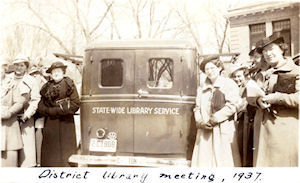 When looking at photos in Nebraska Memories I think it’s important to spend a few minutes looking at the details of a photo. You never know what you may spot. I’ve spotted a few things that made me want to know more. For example go look at this photo of a Group of women standing next to a bookmobile.
When looking at photos in Nebraska Memories I think it’s important to spend a few minutes looking at the details of a photo. You never know what you may spot. I’ve spotted a few things that made me want to know more. For example go look at this photo of a Group of women standing next to a bookmobile.
It’s easy to see that this photo was taken in 1937 at the district library meeting. It looks like all of the women have on coats, hats and gloves. Most of them are holding some type of purse. Did you happen to notice the logo above the license plate? The first time I looked at the details of this photo I was surprised to see the AAA logo on the back of the bookmobile. To be fair I’ve never given the history of AAA much thought but I was surprised to see they were around in 1937. Looking at the AAA website I soon realized I shouldn’t have been surprised. The American Automobile Association was formed in 1902 and introduced services to stranded motorists in 1915. By the time this photo was taken AAA had already been helping stranded motorists for 22 years! I guess I’ll need to start looking at older photos to see if I can find any earlier photos of the logo.
 Here’s another photo for you. This photo of the Wilson Flower Shop is from 1950. Can you spot the logo that I was surprised to see on the door of the delivery truck? Do you recognize FTD Mercury Man? A quick look at the FTD website and I learned that the Florists’ Telegraph Delivery was formed in 1910 and they have been using the Mercury Man logo since 1914.
Here’s another photo for you. This photo of the Wilson Flower Shop is from 1950. Can you spot the logo that I was surprised to see on the door of the delivery truck? Do you recognize FTD Mercury Man? A quick look at the FTD website and I learned that the Florists’ Telegraph Delivery was formed in 1910 and they have been using the Mercury Man logo since 1914.
 As you can tell I come up with a lot of questions when I start looking at the details in a photo. Did you know gazing balls have been around forever? Saying forever might be going a bit too far but I found multiple sites on the web that say gazing balls date back to Italy in the 13th century. I should note however I’m not sure how reliable these sources are. I can say for sure however that there was a mirrored gazing ball in the garden of the Nye residence in Fremont in 1920-1921. It’s prominently featured in the photo of Ray Julius Nye residence formal gardens.
As you can tell I come up with a lot of questions when I start looking at the details in a photo. Did you know gazing balls have been around forever? Saying forever might be going a bit too far but I found multiple sites on the web that say gazing balls date back to Italy in the 13th century. I should note however I’m not sure how reliable these sources are. I can say for sure however that there was a mirrored gazing ball in the garden of the Nye residence in Fremont in 1920-1921. It’s prominently featured in the photo of Ray Julius Nye residence formal gardens.
Unfortunately for me I can’t easily find satisfying answers. In this photo of the Interior of H. A. Sander Store, Papillion, Nebraska do you see all of the bananas along the left side of the photo?  In 1912 how long and how far did the bananas have to travel to reach Papillion? This photo is 100 years old. How much do you think the price of bananas have changed between then and now?
In 1912 how long and how far did the bananas have to travel to reach Papillion? This photo is 100 years old. How much do you think the price of bananas have changed between then and now?
I’m sure it won’t surprise you to read I have more examples of interesting things I’ve found in photos when I take the time to look at the details but I think I’ll save those for another post. Have you spotted any interesting details that make you want to know more? Leave a reply for me and let me know what you’ve found.
Visit Nebraska Memories to search for or browse through many more historical images digitized from photographs, negatives, postcards, maps, lantern slides, books and other materials.
Nebraska Memories is a cooperative project to digitize Nebraska-related historical and cultural heritage materials and make them available to researchers of all ages via the Internet. Nebraska Memories is brought to you by the Nebraska Library Commission. If your institution is interested in participating in Nebraska Memories, see http://nlc.nebraska.gov/nebraskamemories/participation.aspx for more information, or contact Beth Goble, Government Information Services Director, or Devra Dragos, Technology & Access Services Director.
NCompass Live: Digital Humanities and Libraries – Recorded Online Session
 What are the digital humanities and what do they mean for libraries? In this session, Karin Dalziel and Elizabeth Lorang from the Center for Digital Research in the Humanities at the University of Nebraska-Lincoln, will explore major trends in the emerging field of digital humanities.
What are the digital humanities and what do they mean for libraries? In this session, Karin Dalziel and Elizabeth Lorang from the Center for Digital Research in the Humanities at the University of Nebraska-Lincoln, will explore major trends in the emerging field of digital humanities.
Download audio (MP3)
Subscribe via RSS
Subscribe via iTunes
Video (YouTube)
Presentation (SlideShare)
Links (Delicious)
For more information, go to the NCompass Live webpage.
You Can Now Search the 1940 Nebraska Census Records!
I have great news for everyone who has been impatiently waiting since April 2 to search the 1940 Nebraska Census records. You can now search them at: https://familysearch.org/1940census/1940-census-nebraska
If you haven’t been following the 1940 census information the census documents were made available on April 2nd however they had not been indexed. That meant the only way to locate a person in the census was to look at the pages and pages of handwritten records. Now that the indexing has been completed for Nebraska you can simply search for a person. It’s so much simpler.
I’ve been trying to locate one of my grandparents since April 2nd! My relatives where positive I’d find them living in a specific area of Omaha. Unfortunately for me that general area covered multiple enumeration districts. I looked through hundreds of census pages without any luck. After a quick search this morning I found my grandparents living in Grand Island. I will be having a little talk with my relatives tonight regarding their inaccurate information!
As I was using the search form I stumbled across a search feature I wanted to share with everyone. I have a relative with a Czech last name I can never remember how to spell so I tried using a wildcard. It worked after a couple of trials and errors. I consulted help and learned the system supports 2 types of wildcards.
- ? – Use the question mark to represent any one character
- * – Use the asterisk sign to represent zero or more characters
The important thing to note however is that in order to use a wildcard your word must have at least three other letters! It took me a few tries to get it right because I was only using 2 letters.
Learn more about the 1940 census on our website at: http://nebraskaccess.ne.gov/1940census.
To keep informed on which states are searchable go to: https://familysearch.org/1940census/?cid=fsHomeT1940Text_v2. There are currently 29 other states that are searchable.
Good luck searching!
Posted in Census, General, Information Resources, Technology, What's Up Doc / Govdocs
Tagged census
1 Comment
NCompass Live: All About ALTAFF: A conversation with Sally Gardner Reed – Recorded Online Session
 Sally Gardner Reed is the Executive Director of the Association of Library Trustees, Advocates, Friends and Foundations (ALTAFF). Sally will share her ideas about ALTAFF’s mission and vision and how Nebraska and its libraries can benefit and fully use the resources available through this dynamic ALA division. Learn how Nebraska’s unique statewide membership, including the online Trustee Academy which is available free to all Nebraska public libraries, can benefit Nebraska – its libraries and people.
Sally Gardner Reed is the Executive Director of the Association of Library Trustees, Advocates, Friends and Foundations (ALTAFF). Sally will share her ideas about ALTAFF’s mission and vision and how Nebraska and its libraries can benefit and fully use the resources available through this dynamic ALA division. Learn how Nebraska’s unique statewide membership, including the online Trustee Academy which is available free to all Nebraska public libraries, can benefit Nebraska – its libraries and people.
Download audio (MP3)
Subscribe via RSS
Subscribe via iTunes
Video (YouTube)
ALTAFF web site
For more information, go to the NCompass Live webpage.
Digest of Education Statistics for 2011 Available
The 2011 Digest of Education Statistics was released last week by the National Center for Education Statistics (NCES). This publication is a compendium of data from several sources, including the results of surveys from NCES. It contains information on such topics as the number of schools and colleges, teachers, school enrollments, and graduates. You can find the complete document at http://nces.ed.gov/programs/digest/d11/.
Celebrating Dear Old Dad
The first Father’s Day celebration was held in Spokane, Washington, in 1910. But it wasn’t until forty years ago Father’s Day finally became a permanent national holiday. It took 62 years of promotion and lobbying to overcome resistance to another “commercial” holiday.
 No matter how you celebrate Father’s Day (commercially or otherwise), it can be great fun to look back at images of fathers from the past–or grandfathers, great-grandfathers and fathers of the future. Many images of fathers in Nebraska Memories were taken by Harvey L. Boston, owner of a photography studio in David City, Nebraska, (from 1893 to 1927) including a self-portait with his two young daughters.
No matter how you celebrate Father’s Day (commercially or otherwise), it can be great fun to look back at images of fathers from the past–or grandfathers, great-grandfathers and fathers of the future. Many images of fathers in Nebraska Memories were taken by Harvey L. Boston, owner of a photography studio in David City, Nebraska, (from 1893 to 1927) including a self-portait with his two young daughters.
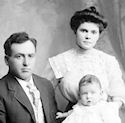
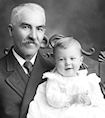 Boston’s photographs include young fathers, such as Fred Keller, at left with his wife, Alice, and their young child. The collection also includes fathers who might have started a second family at an older age, such as William H. McGaffin, at right, who was photographed with his son Wesley, born when his father over 60. McGaffin, a widower who married a second time, had already had 14 children with his first wife.
Boston’s photographs include young fathers, such as Fred Keller, at left with his wife, Alice, and their young child. The collection also includes fathers who might have started a second family at an older age, such as William H. McGaffin, at right, who was photographed with his son Wesley, born when his father over 60. McGaffin, a widower who married a second time, had already had 14 children with his first wife.
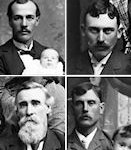
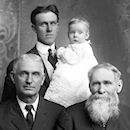
 Other Boston images show multiple generations. The collage to the far left includes members of the Gilbert W. Rogers family; in the photograph two fathers are holding younger children. In the center are four generations of the H. W. Lichliter family. And to the right are four generations of the Harper family: James, Morgan, Jack and Phillip.
Other Boston images show multiple generations. The collage to the far left includes members of the Gilbert W. Rogers family; in the photograph two fathers are holding younger children. In the center are four generations of the H. W. Lichliter family. And to the right are four generations of the Harper family: James, Morgan, Jack and Phillip.

 Some Nebraska Memories images show fathers at work with their children, such as Joe Gatto with his two sons in his store in Lincoln, Nebraska (from the Townsend Studio collection). Others show them relaxing with their families, like the John Birkel family to the right. But, work or play, take some time to celebrate all fathers!
Some Nebraska Memories images show fathers at work with their children, such as Joe Gatto with his two sons in his store in Lincoln, Nebraska (from the Townsend Studio collection). Others show them relaxing with their families, like the John Birkel family to the right. But, work or play, take some time to celebrate all fathers!
Visit Nebraska Memories to search for or browse through many more historical images digitized from photographs, negatives, postcards, maps, lantern slides, books and other materials.
Nebraska Memories is a cooperative project to digitize Nebraska-related historical and cultural heritage materials and make them available to researchers of all ages via the Internet. Nebraska Memories is brought to you by the Nebraska Library Commission. If your institution is interested in participating in Nebraska Memories, see http://nlc.nebraska.gov/nebraskamemories/participation.aspx for more information, or contact Beth Goble, Government Information Services Director, or Devra Dragos, Technology & Access Services Director.
Graduation
 The month of May is just another memory. For some recent graduates the month of May marks an important milestone in their lives. One hundred years ago in 1912 a group of students at Union College were celebrating their graduation as we can see in this photo of their commencement in Nebraska Memories.
The month of May is just another memory. For some recent graduates the month of May marks an important milestone in their lives. One hundred years ago in 1912 a group of students at Union College were celebrating their graduation as we can see in this photo of their commencement in Nebraska Memories.
 There is a small but interesting collection of items relating to graduations in Nebraska Memories. We can see the first graduating class from the Nebraska State Normal School at Kearney from 1906. There is also a picture of four marshals from the 1948 commencement at the Nebraska State Teachers College in Wayne.
There is a small but interesting collection of items relating to graduations in Nebraska Memories. We can see the first graduating class from the Nebraska State Normal School at Kearney from 1906. There is also a picture of four marshals from the 1948 commencement at the Nebraska State Teachers College in Wayne.
The collection also includes a number of programs from commencement exercise. Looking at the program for the 19th annual commencement of the University of Nebraska in Lincoln from June 7, 1888 I was surprised to see two names I recognized. The first name was Frank Henry Woods. Frank Woods and his brothers Mark W. and George J. formed the Woods Brothers Companies in 1889. Today in Lincoln their company name can still be seen written in stone on the façade of a building on 13th street between N and O. Also when driving around Lincoln you may see the family name in front of a property being sold by the Woods Bros Realty company. Frank Woods is also known for starting the Lincoln Telephone & Telegraph in 1904. The Frank H. Woods Telephone Museum, which is located in Lincoln, bears his name.
name can still be seen written in stone on the façade of a building on 13th street between N and O. Also when driving around Lincoln you may see the family name in front of a property being sold by the Woods Bros Realty company. Frank Woods is also known for starting the Lincoln Telephone & Telegraph in 1904. The Frank H. Woods Telephone Museum, which is located in Lincoln, bears his name.
The other name I recognized in the same commencement program was Roscoe Pound. Pound was a legal scholar and educator. He served as the Dean of the University of Nebraska College of Law and later as the Dean of Harvard Law School. Lincolnites may also recognize the Pound name because of Pound Middle School which was named after the Pound family including Judge Stephen Bosworth Pound, Roscoe, Louise and Olivia Pound.
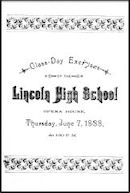 When looking at the 1888 Lincoln High School Class-Day Exercises program I spotted the name Mark Woods. Mark M. Woods was listed as speaking about “Our Nation’s Coast Defenses” while Mark W. was listed as being part of the Class of 1888 and completed the Latin Course. Could this be Frank Woods brother? Unfortunately it’s not a question I was able to answer. Do you know the answer? Leave me a comment if you know!
When looking at the 1888 Lincoln High School Class-Day Exercises program I spotted the name Mark Woods. Mark M. Woods was listed as speaking about “Our Nation’s Coast Defenses” while Mark W. was listed as being part of the Class of 1888 and completed the Latin Course. Could this be Frank Woods brother? Unfortunately it’s not a question I was able to answer. Do you know the answer? Leave me a comment if you know!
Visit Nebraska Memories to search for or browse through many more historical images digitized from photographs, negatives, postcards, maps, lantern slides, books and other materials.
Nebraska Memories is a cooperative project to digitize Nebraska-related historical and cultural heritage materials and make them available to researchers of all ages via the Internet. Nebraska Memories is brought to you by the Nebraska Library Commission. If your institution is interested in participating in Nebraska Memories, see http://nlc.nebraska.gov/nebraskamemories/participation.aspx for more information, or contact Beth Goble, Government Information Services Director, or Devra Dragos, Technology & Access Services Director.
NCompass Live: Addressing Your Roots – Searching the 1940 Census – Recorded Online Session
![]() Do you know where your Uncle Fred lived in Omaha? If not, the Library Commission has some resources to help, as knowing his address may be key to finding him in the 1940 Census. Allana Novotny, Beth Goble and Devra Dragos will share tips and resources for searching this census before the name-indexing is completed.
Do you know where your Uncle Fred lived in Omaha? If not, the Library Commission has some resources to help, as knowing his address may be key to finding him in the 1940 Census. Allana Novotny, Beth Goble and Devra Dragos will share tips and resources for searching this census before the name-indexing is completed.
Download audio (MP3)
Subscribe via RSS
Subscribe via iTunes
Video (YouTube)
Links (Delicious)
For more information, go to the NCompass Live webpage.
Posted in Census, Education & Training, General, Information Resources, Technology, What's Up Doc / Govdocs
Tagged census
Leave a comment
The Season of New Life
Spring is the season of new life. At my house I have baby bunnies munching on my columbines, baby birds sitting on the feeder begging to be fed by their parents , baby dandelions sprouting, and a fresh new crop of mosquitos trying to get their first meal from ME. New arrivals in the human world are not limited to spring, but the abundance of youngsters of all species this month led me to search on the word “baby” in Nebraska Memories to find out what would be revealed. People love babies and love taking their pictures, so it was not a surprise to find nearly 90 images. Many of them are studio portraits.
 I confess to being guilty of taking a few “nearly naked” baby pictures of my own children, although not at a studio. Young Rudolph Nuttelman of Rising City, clad only in his diaper, is at ease and smiling in this 1906 photo from the Boston Studio Project. I am always amazed by the clarity of scanned images from glass plate negatives and can count each one of his toes. Perhaps a parent was standing behind the photographer doing something silly to make him smile.
I confess to being guilty of taking a few “nearly naked” baby pictures of my own children, although not at a studio. Young Rudolph Nuttelman of Rising City, clad only in his diaper, is at ease and smiling in this 1906 photo from the Boston Studio Project. I am always amazed by the clarity of scanned images from glass plate negatives and can count each one of his toes. Perhaps a parent was standing behind the photographer doing something silly to make him smile.
 This portrait of Agnes Birkel, age 21 months when the photo was taken in 1908, is also from the Boston Studio Project. She and the puppy beside her are an adorable pair. Agnes is looking at someone who is making her smile, but the puppy looks rather sleepy to me. I hope they enjoyed growing up together!
This portrait of Agnes Birkel, age 21 months when the photo was taken in 1908, is also from the Boston Studio Project. She and the puppy beside her are an adorable pair. Agnes is looking at someone who is making her smile, but the puppy looks rather sleepy to me. I hope they enjoyed growing up together!
Babies can be hard to get to sleep, but singing to them helps. Croonings of the Winds is a collection of 12 “slumber songs” in the Polley Music Library collection. This verse from Summer Lullaby by Eudora S. Bumstead really evokes a Nebraska summer evening.
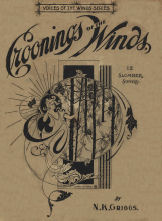 The sun has gone from the shining skies, Bye baby, bye
The sun has gone from the shining skies, Bye baby, bye
The dandelions have closed their eyes, Bye baby, bye
And stars are lighting their lamps to see
If babe and birdy and squir’l all three
Are sound asleep as they ought to be
Bye, baby, bye
Visit Nebraska Memories to search for or browse through many more historical images digitized from photographs, negatives, postcards, maps, lantern slides, books and other materials.
Nebraska Memories is a cooperative project to digitize Nebraska-related historical and cultural heritage materials and make them available to researchers of all ages via the Internet. Nebraska Memories is brought to you by the Nebraska Library Commission. If your institution is interested in participating in Nebraska Memories, see http://nlc.nebraska.gov/nebraskamemories/participation.aspx for more information, or contact Beth Goble, Government Information Services Director, or Devra Dragos, Technology & Access Services Director.
New Book Club Kits added for Young Readers
Two new book club kits for young readers have been added to our collection. I asked Sally Snyder to write a bit about the two titles. Please use this request form if you’d like to borrow either of these kits or any others from our collection.
Out of My Mind – 4 copies
Melody has a sharp brain in a body with cerebral palsy. She is frustrated with learning the alphabet over and over when she has a photographic memory (or nearly so). Since she cannot talk, the neighbor, Mrs. V., first rigs up a word and alphabet board on her wheelchair. Finally Melody is sent to “inclusion classes” where children from room H-5 experience life in a real classroom for certain subjects. Melody loves this chance to learn. But it isn’t until she gets her best “gizmo” ever that she really has a chance to become a part of the class.
The Best Bad Luck I Ever Had – 4 copies
Dit (turns 13 during the book) is disappointed that the new postmaster has a daughter instead of a son. It is 1917 and Dit was looking forward to a summer of fishing and baseball with a new friend. Emma is a girl, and she is black. As the summer progresses, they begin a friendship, but there are those in town who think a white boy should not spend time with a black girl. Civil rights have yet to arrive in the U.S. especially in the South. Over the summer and into the school year, trouble is brewing. A wonderful book about coming of age and finding the courage to do what is right, even if it is hard.
Posted in Books & Reading, General, Information Resources
1 Comment
May Day Celebration
Next week is the beginning of May, which includes the celebration of May Day on the first of the month. This holiday is often celebrated in the United States by making May baskets that are usually filled with flowers or treats and left on someone’s doorstep. The giver rings the bell and runs away hoping that the receiver does not catch them and if they are caught a kiss will be exchanged.
In other parts of the world, mainly Western Europe, Maypole dancing is a tradition that signals the end of winter. Participants form a circle around an erected pole to perform the dance. This pole is usually decorated with flags, flowers, garlands, etc., before the event starts. Performers revolve around the pole holding a ribbon, the other end of which is tied to the pole. They first dance in a direction intertwining the ribbon on the pole; later, they perform a similar dance in the reverse direction to unravel the intertwined ribbon.
This image in Nebraska Memories shows students at the Nebraska State Normal School at Kearney (now the University of Nebraska at Kearney) performing a Maypole dance. Maypole dances were held every May from 1912 to 1937; this photograph captures one of the earlier dances.
Many other images of campus life are available as part of the University of Nebraska at Kearney collection.
Visit Nebraska Memories to search for or browse through many more historical images digitized from photographs, negatives, postcards, maps, lantern slides, books and other materials.
Nebraska Memories is a cooperative project to digitize Nebraska-related historical and cultural heritage materials and make them available to researchers of all ages via the Internet. Nebraska Memories is brought to you by the Nebraska Library Commission. If your institution is interested in participating in Nebraska Memories, see http://nlc.nebraska.gov/nebraskamemories/participation.aspx for more information, or contact Beth Goble, Government Information Services Director, or Devra Dragos, Technology & Access Services Director.
Is there a doctor in the house?
 Have you ever needed a ride to the hospital? Or emergency medical care? Consider the medical care available 80-100 years ago. It used to be that ambulances simply transported a person to the hospital (or the morgue). Check out the image of this ambulance used in Lincoln in 1922. (Hodgman ambulance, Townsend Studio collection) You might not get much medical aid on the trip, but there are curtains to close for privacy.
Have you ever needed a ride to the hospital? Or emergency medical care? Consider the medical care available 80-100 years ago. It used to be that ambulances simply transported a person to the hospital (or the morgue). Check out the image of this ambulance used in Lincoln in 1922. (Hodgman ambulance, Townsend Studio collection) You might not get much medical aid on the trip, but there are curtains to close for privacy.
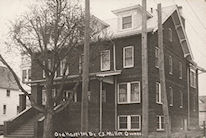 No matter how you reached the hospital all those years ago, you might still have a problem getting into the building. At the Ord Hospital (and others), you had to navigate quite a few stairs to the front entrance. (Ord Hospital, Nebraska State Historical Society collection)
No matter how you reached the hospital all those years ago, you might still have a problem getting into the building. At the Ord Hospital (and others), you had to navigate quite a few stairs to the front entrance. (Ord Hospital, Nebraska State Historical Society collection)
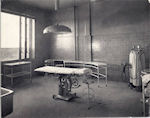 Once inside the hospital, there weren’t many bells and whistles like today. In this image from the Alegent Health Immanuel Medical Center collection, the operating room is plain and simple. A basin for the staff to wash up in, a table that could be raised and lowered, a single light fixture above the table–but hey, there were large windows for extra light, and they opened for fresh air, too.
Once inside the hospital, there weren’t many bells and whistles like today. In this image from the Alegent Health Immanuel Medical Center collection, the operating room is plain and simple. A basin for the staff to wash up in, a table that could be raised and lowered, a single light fixture above the table–but hey, there were large windows for extra light, and they opened for fresh air, too.
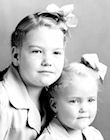
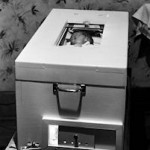 Other mechanical improvements, such as the incubator in the image to the left, may look clunky and out-of-date to us, but you can’t argue with success. The image to the right shows Nancy Lonn, the baby in the incubator, at age four with her older sister Belva Joy. (Thorpe Opera House Foundation/Boston Studio Project collection)
Other mechanical improvements, such as the incubator in the image to the left, may look clunky and out-of-date to us, but you can’t argue with success. The image to the right shows Nancy Lonn, the baby in the incubator, at age four with her older sister Belva Joy. (Thorpe Opera House Foundation/Boston Studio Project collection)
Check out more medical-related images or visit Nebraska Memories to search for or browse through many more historical images digitized from photographs, negatives, postcards, maps, lantern slides, books and other materials.
Nebraska Memories is a cooperative project to digitize Nebraska-related historical and cultural heritage materials and make them available to researchers of all ages via the Internet. Nebraska Memories is brought to you by the Nebraska Library Commission. If your institution is interested in participating in Nebraska Memories, see http://nlc.nebraska.gov/nebraskamemories/participation.aspx for more information, or contact Beth Goble, Government Information Services Director, or Devra Dragos, Technology & Access Services Director.
Posted in General, Information Resources, Nebraska Memories, Technology
1 Comment
Detailed 2010 Census Data for Nebraska Released Today
The Census Bureau announced this morning that new, detailed demographic information from the 2010 Census for up to 331 different race and ethnic groups down to the census tract level has been released for Nebraska, California, Colorado, Montana,and Wyoming.
The Summary File 2 tables can be found on the Census Bureau’s American FactFinder website at <http://factfinder2.census.gov> by using the “Population Groups” filter to select the specific race or ethnic groups of interest. While a variety of tables will be available, a good place to start is the Profile of General Population and Housing Characteristics, which shows a summary of characteristics for one geographic area at a time.
These Summary File 2 tables add a new layer of detail to the population and housing topics released last year from the 2010 Census. Information, such as age, relationship and homeownership, previously available only for an area’s entire population is now available for specific race and ethnic groups in that community.
The statistics are available for counties, county subdivisions, places, census tracts, ZIP Code tabulation areas, congressional districts for the 111th Congress, American Indian and Alaska Native areas within the states released, tribal subdivisions, metropolitan areas and Hawaiian home lands.
To preserve confidentiality, only geographic entities with a population of at least 100 for the specified group are available in the summary file.
Posted in Census, General, Information Resources, What's Up Doc / Govdocs
Tagged census
Leave a comment
Alex Matthews – Cassidy McCabe Mystery Series
Recently, our book club collection was gifted with four sets of books (Secret’s Shadow, Satan’s Silence, Death’s Domain, and Wedding’s Widow) by the Chicago author Alex Matthews. If you’re unfamiliar with Matthews, she is the writer of the Cassidy McCabe mysteries. Cassidy McCabe is a psychotherapist who lives and works in the Oak Park Neighborhood, owns a cat named Starshine, and spends her time as an amateur detective. I asked the Library Commission book club to read and discuss the first title in her series, Secret’s Shadow. There were comments that the story was good and moved right along. There were criticisms from some about Cassidy too easily dismissing her intuition regarding signals of danger, but most generally sensed an overall strength in her character. Some of the readers were fond of Cassidy; others struggled with her insecurity in her relationships. The setting of Chicago and its description was given high marks in its accuracy. Most important to any title read by a club is the discussion which was described as lively and opinionated. The readers disagreed about several items and I think those are always the most memorable meetings. The more opposite the opinions; the more members work to articulate why they are taking a particular position. If your book club is looking for a Midwest setting for a book, considering requesting one of Matthew’s titles for your book group and many thanks to Alex for providing her books to our library.
Posted in Books & Reading, General, Information Resources
Leave a comment
Robert Groves Leaving Census Bureau
Yesterday Robert Groves, Director of the U.S. Census Bureau, announced that he is leaving the Bureau to become the next provost of Georgetown University. In his message to CIC and SDC networks, he stated
With mixed emotions, I am writing to let you know that I have been asked to become the next provost of Georgetown University, and I have made the difficult decision to accept that position, beginning in late August 2012.
While I am honored by this rare personal and professional opportunity to help lead Georgetown to even greater heights than it already enjoys, I must also tell you that I am enormously proud of the work we have accomplished together over the past three years.
Together, we have begun transforming the Census Bureau to better face the challenges ahead. I am confident that the current leadership of the Census Bureau is devoted to carrying the shared vision forward — that this agency will continue to provide the key economic and social statistical information the country so deeply needs, with cost-efficient excellence. For the next four months I will do all I can to continue the innovations we have together begun.
I have been honored to work with you. You are truly a set of talented, skilled, committed folks who are working to make this a better place for future generations.
There is much to do in the coming months here at the Bureau. I look forward to working with all of you.
More commentary on the Census Bureau and appointing a new director are in this Washington Post article.
Posted in Census, General, Information Resources, What's Up Doc / Govdocs
Tagged census
Leave a comment
